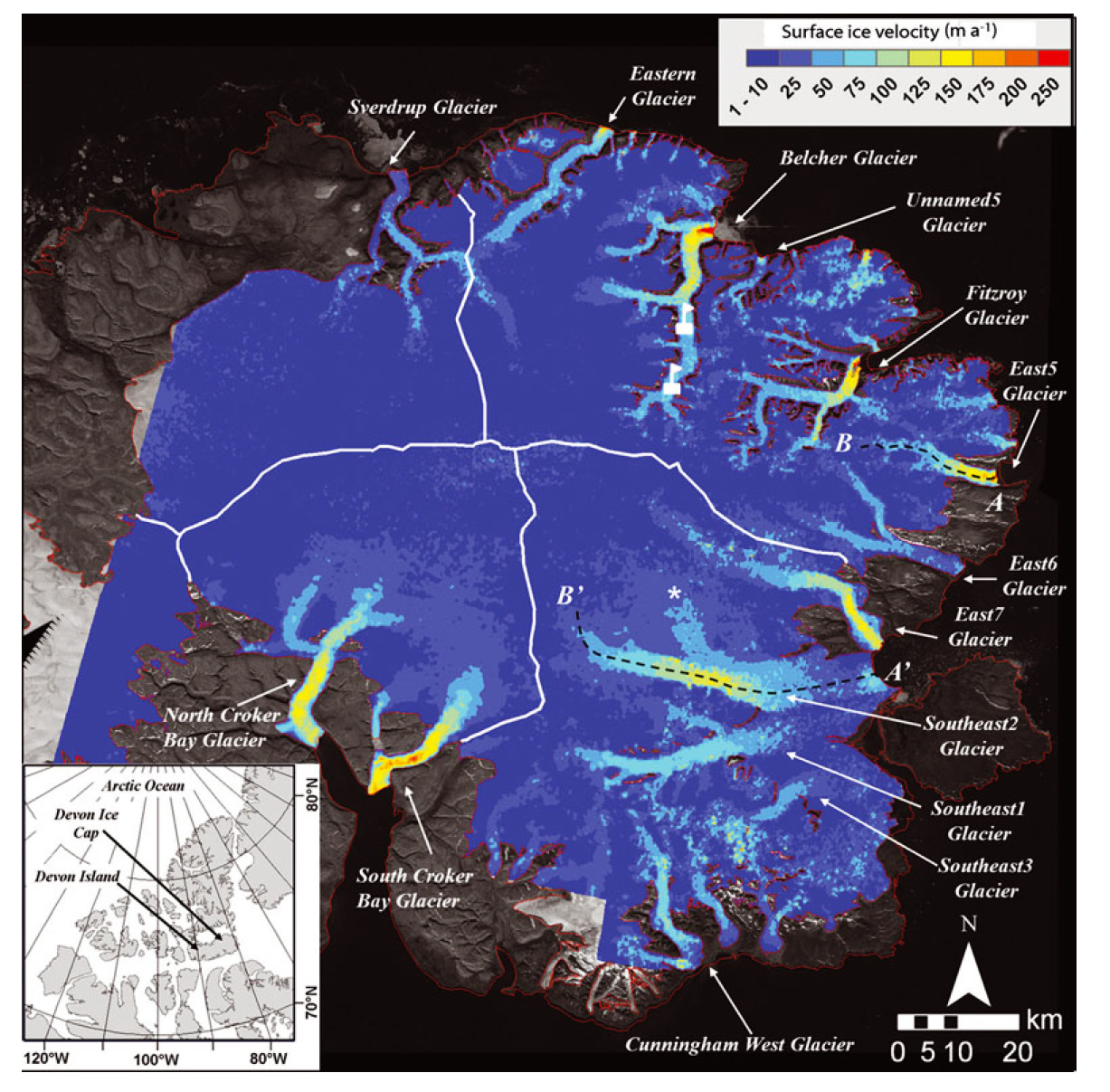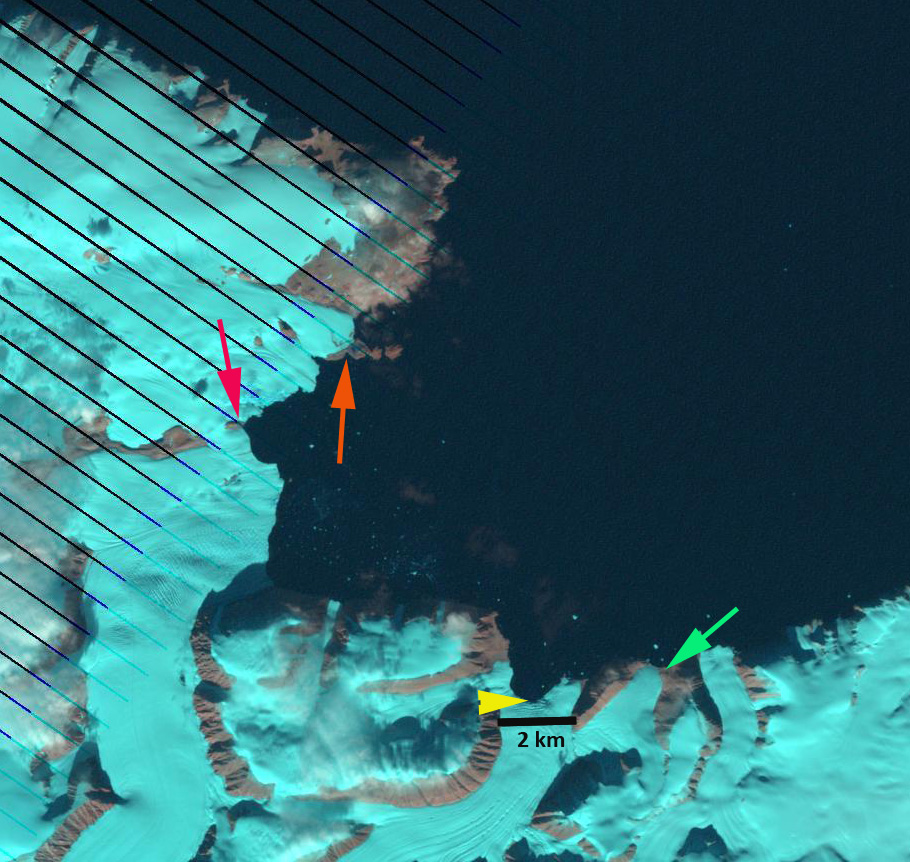June 9, 2012
Devon Ice Cap Northern Outlet Glacier Retreat
Posted by Mauri Pelto
The Devon Ice Cap on Devon Island in the Canadian Arctic ice cap’s area has an area of 15,000 km2, with a volume of 3980 km3. The ice cap area decreased by 600 km2 (4%) between 1960 and 2000 (Sharp et al, in press). The ice cap has been the focus of an ongoing research program led by the University of Alberta Arctic and Alpine Research Group and Natural Resources Canada in Ottawa. The mass balance from 1960-2009 has been cumulatively -5.6 m, with nine of the eleven most negative years occurring since 1998. The Devon Ice Cap’s negative balance has been due to warming and greater ablation, as the upper part of the glacier has seen some increase in accumulation, which has been more than offset by increased melting ( Sharp et al, 2011). Belcher Glacier is the the principal outlet glacier calving up to 40% of the total iceberg volume from the ice cap.  Belcher Glacier and its neighbor Unnamed5 Glacier are the focus of this post. A recent study by Van Wychen et al (2012) focused on velocity changes of the Devon ice Cap. The fastest velocities of 200-250 meters/year are at the front of the Belcher Glacier. A comparison between Belcher Glacier’s velocity from the 1991-2000 period and 2009 indicate that Belcher Glacier velocity has declined at the glacier front recently, which has likely aided the glacier in slowing retreat, an excellent time lapse gives a sense of the dynamics. [youtube=http://www.youtube.com/watch?v=WG-xx_J4SXQ] Here we used 1998 (top), 2008 (second image) and 2010 Landsat imagery(bottom image) combined with Geoeye imagery (third image)from 2010 to identify changes in glaciers adjacent to the Belcher Glacier. To the north of Belcher Glacier a small nunatak is evident at the red arrow. This nunatak is 500 meters inland from the terminus in 1998 and is at the terminus in 2010. The orange arrow indicates the terminus of a land terminating glacier which in 1998 reached a small inlet in the peninsula emerging from under the ice cap. By 2010 the glacier has pulled back 250 meters from this inlet. The yellow arrow indicates the terminus change of Unnamed5 Glacier. The glacier has pulled back to the base of a zone of intense crevassing between 1998 and 2010 a retreat of 500 m. The next glacier to the east in 1998 has a 600 meter wide margin in the ocean. By 2010 the glacier front is in contact with the ocean for less than half this length.
Belcher Glacier and its neighbor Unnamed5 Glacier are the focus of this post. A recent study by Van Wychen et al (2012) focused on velocity changes of the Devon ice Cap. The fastest velocities of 200-250 meters/year are at the front of the Belcher Glacier. A comparison between Belcher Glacier’s velocity from the 1991-2000 period and 2009 indicate that Belcher Glacier velocity has declined at the glacier front recently, which has likely aided the glacier in slowing retreat, an excellent time lapse gives a sense of the dynamics. [youtube=http://www.youtube.com/watch?v=WG-xx_J4SXQ] Here we used 1998 (top), 2008 (second image) and 2010 Landsat imagery(bottom image) combined with Geoeye imagery (third image)from 2010 to identify changes in glaciers adjacent to the Belcher Glacier. To the north of Belcher Glacier a small nunatak is evident at the red arrow. This nunatak is 500 meters inland from the terminus in 1998 and is at the terminus in 2010. The orange arrow indicates the terminus of a land terminating glacier which in 1998 reached a small inlet in the peninsula emerging from under the ice cap. By 2010 the glacier has pulled back 250 meters from this inlet. The yellow arrow indicates the terminus change of Unnamed5 Glacier. The glacier has pulled back to the base of a zone of intense crevassing between 1998 and 2010 a retreat of 500 m. The next glacier to the east in 1998 has a 600 meter wide margin in the ocean. By 2010 the glacier front is in contact with the ocean for less than half this length. 


 . Further to the east from Belcher and Unnamed5 Glacier there is a set of three islands that are losing contact with the Devon Ice Cap between the 1998 Landsat and 2009 Geoeye imagery, violet arrows 2009. The losses paralell those from other Canadian Arctic glaciers, Penny Ice Cap.
. Further to the east from Belcher and Unnamed5 Glacier there is a set of three islands that are losing contact with the Devon Ice Cap between the 1998 Landsat and 2009 Geoeye imagery, violet arrows 2009. The losses paralell those from other Canadian Arctic glaciers, Penny Ice Cap.



 Dean of Academic Affairs at Nichols College and Professor of Environmental Science at Nichols College in Massachusetts since 1989. Glaciologist directing the North Cascade Glacier Climate Project since 1984. This project monitors the mass balance and behavior of more glaciers than any other in North America.
Dean of Academic Affairs at Nichols College and Professor of Environmental Science at Nichols College in Massachusetts since 1989. Glaciologist directing the North Cascade Glacier Climate Project since 1984. This project monitors the mass balance and behavior of more glaciers than any other in North America.